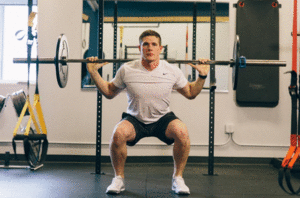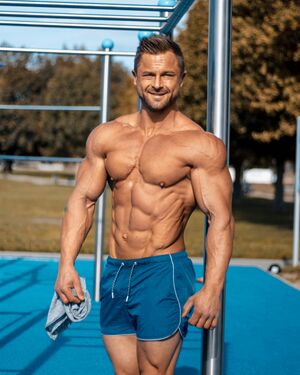Testosterone
Original Editor - Lucinda hampton
Top Contributors - Lucinda hampton
Introduction[edit | edit source]
Testosterone is the primary male hormone, but females also have small amounts of it. It is a steroid hormone, produced in men’s testicles and women’s ovaries, additionally the adrenal glands produce small amounts. During puberty in boys, testosterone is one of the main factors causing physical changes for example increased muscle, deeper voice and hair growth. Importantly, having optimal levels throughout adulthood and during old age is needed for good health
In adults, healthy levels are important for general health, disease risk, body composition and sexual function (playing an important role in both male and female health and sexual well-being).[1]
Male Sex Characteristics[edit | edit source]
Testosterone is involved in regulating secondary male characteristics. These secondary sex characteristics include male hair patterns, vocal changes, and voice deepening, anabolic effects, which include growth spurts in puberty (testosterone increases tissue growth at the epiphyseal plate early on and ultimate closure of plate later in puberty) and skeletal muscle growth (testosterone stimulates protein synthesis). Testosterone also stimulates erythropoiesis, the reason why males have a higher hematocrit than females.
As men age, testosterone levels tend to fall causing men to experience a decrease in testicular size, a fall in libido, lower bone density, muscle mass decline, increased fat production, and decreased erythropoiesis (leading to possible anemia).[2]
Exercise and Testosterone[edit | edit source]
Testosterone is responsible for muscle protein growth and repairs muscle damage which can occur during exercise. Males muscle mass, strength, sex drive, and sperm count are linked to his testosterone levels. As a man ages, testosterone levels naturally decreases Testosterone is able to prevents muscle breakdown. Resistance and Hight Intensity Interval Training (HITT) exercises can cause beneficial increases to testosterone levels.[3] See Exercise Endocrine System Interaction
Fatherhood[edit | edit source]
New research shows that becoming a father leads to a sharp decline in testosterone. It seems that although high levels of the hormone may help men win a mate, testosterone-fueled traits such as aggression and competition are less applicable when it comes to raising children.[4]
Anabolic Steroids and Testosterone[edit | edit source]
Anabolic steroids cause hormonal imbalances in the body and their use can result in an unnatural increase of testosterone levels, which, in turn decreases the body’s own production of testosterone. Some of the side effects of steroid abuse occur when a user stops taking the drug because the body has unusually low levels of testosterone. The effects of hormonal imbalances caused by steroids often have the opposite effect on men and women but women also face many of the same health issues and risks that men do when using steroids.[5]
The Male Athlete Triad and Testosterone[edit | edit source]
The Male Athlete Triad (MAT) constitutes of a decline in athletic performance accompanied by low energy availability, low testosterone, and poor bone health. While the decrease in athletic performance is problematic, MAT can also have long-term, irreversible consequences, so it’s important athletes, parents, coaches, health care providers understand the triad, who is at risk, and how to prevent it.[6]
Too Much/Too Little[edit | edit source]
Over-production of androgens (sec hormones, primarily testosterone) can occur in the following conditions: polycystic ovarian syndrome (PCOS), adrenal tumors, ovarian or testicular tumors, Cushing syndrome, and as a result of exogenous steroid use.
Decreased production of testosterone can occur with for example, aging, certain medications, chemotherapy, hypothalamus-pituitary axis disorders, primary hypogonadism and with genetic disorders such as Klinefelter syndrome.[2]
References[edit | edit source]
- ↑ Healthline 8 Proven Ways to Increase Testosterone Levels Naturally Available:https://www.healthline.com/nutrition/8-ways-to-boost-testosterone#3.-Minimize-Stress-and-Cortisol-Levels (accessed 28.8.2022)
- ↑ 2.0 2.1 Nassar GN, Leslie SW. Physiology, testosterone. Available: https://www.statpearls.com/articlelibrary/viewarticle/29996/ (accessed 28.8.2022)
- ↑ Exercise Endocrine System Interaction
- ↑ Grebe NM, Sarafin RE, Strenth CR, Zilioli S. Pair-bonding, fatherhood, and the role of testosterone: A meta-analytic review. Neuroscience & Biobehavioral Reviews. 2019 Mar 1;98:221-33. Available:https://pubmed.ncbi.nlm.nih.gov/30639674/ (accessed 28.8.2022)
- ↑ Addiction centre Steroids Available: https://www.addictioncenter.com/stimulants/steroids/symptoms-signs/ (accessed 27.8.2022)
- ↑ The sports institute What to know about MAT Available: https://thesportsinstitute.com/what-to-know-about-the-male-athlete-triad/ (accessed 27.8.2022)











